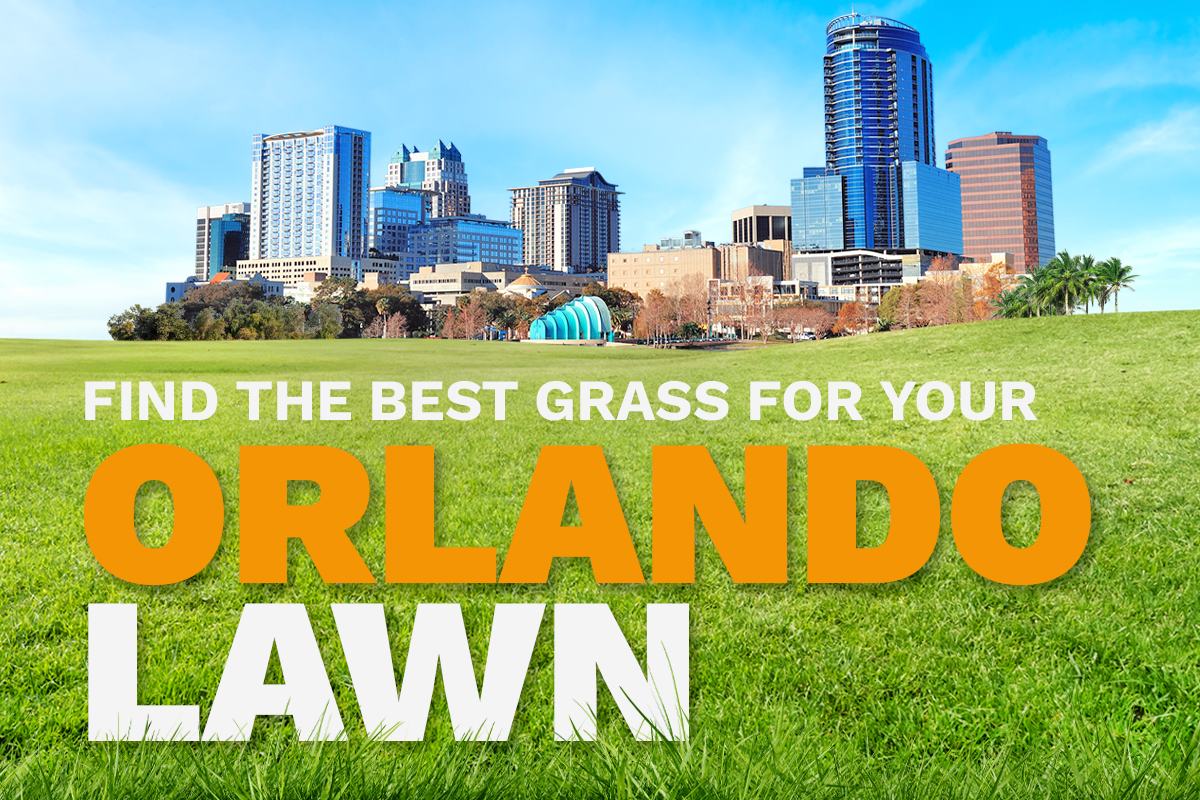
The best grass types for the Orlando area are heat- and drought-tolerant, able to thrive in hot and humid summers and withstand seasonal moisture extremes.
St. Augustine and bahia are the most common choices for Orlando’s home lawns, with Zoysia, Bermuda, and centipede close behind. If you want to overseed your lawn for winter, ryegrass is the best option.
What’s the best grass type for YOUR Orlando lawn? Take the quiz below, then read more about each of the 5 best grass types for Orlando.
Orlando Lawn Grass Decision Calculator

Find the Orlando grass that is best suited to the conditions of your yard and your maintenance preferences. Our calculator considers key factors such as shade tolerance, foot traffic, and maintenance requirements.
Grass Match Calculator for Orlando
Find the perfect grass for your Central Florida lawn
Your Personalized Grass Recommendations
Key Local Challenges to Consider
- Summer fertilizer restrictions in Orange, Lake, and Seminole counties prohibit nitrogen and phosphorus applications from June 1 to Sept. 30.
- Frequent afternoon thunderstorms and tropical weather/hurricanes can cause drainage issues.
- Intense UV exposure requires heat-tolerant grass varieties.
- High humidity creates ideal conditions for pests (chinch bugs, mole crickets) and diseases (large patch, grey leaf spot).
1. St. Augustinegrass
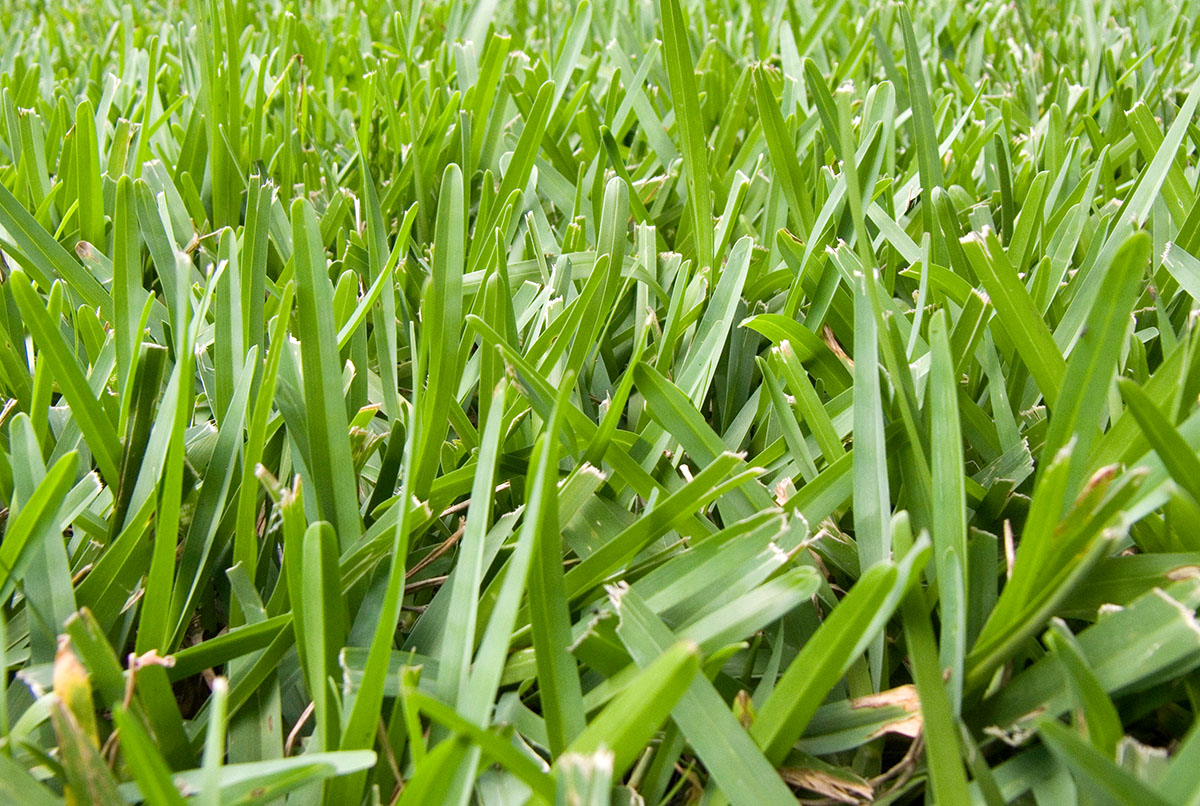
The most common grass in Orlando, St. Augustine, is easy to install, grows fast, and creates dark green lawns people love. Plus, it can tolerate partial shade and the higher soil pH in Orlando’s newly developed neighborhoods, such as Northlake Park and Horizon West.
The trade-off? High-maintenance. Expect frequent watering, mowing, and fertilizer applications, as well as regular fungicide and insecticide treatments to protect it from diseases and chinch bugs. It’s also a heavy thatch producer and prone to weeds.
Avoid mowing your St. Augustine too short. In Orlando’s hot and humid climate, scalping causes patchy lawns, weeds, and burnout during dry weeks, says Orlando LawnStarter Pro Kody Robinson of ProCutz Lawncare Landscaping LLC.
- Foot traffic tolerance: Moderate
- Mowing height: 3.5-4 inches for standard, 2.5 inches for dwarf cultivars
- Potential for diseases: Moderate to high; susceptible to fungal diseases, such as gray leaf spot, large patch, take-all root rot
- Common cultivars in Orlando: Floratam, Palmetto, Citra Blue, Bitter Blue, Classic
See Related: Restrictions and Tips for Watering Your Orlando Lawn
2. Bahiagrass

Orlando’s second most popular grass is bahiagrass, the best drought-tolerant and low-maintenance option. It needs minimal fertilizer and, once established, Orlando’s typical afternoon thunderstorms provide all the moisture it needs. You’ll only water it during prolonged droughts.
On the downside, bahia lawns are less dense and more prone to foot traffic damage and weeds. To improve thickness and keep it weed-free, overseed bahia annually or allow it to form seedheads and seed itself.
It needs acidic soil and won’t thrive in alkaline conditions.
- Foot Traffic Tolerance: Low
- Mowing Height: 3-4 inches
- Potential for Diseases: Low
- Common Cultivars in Orlando: Argentine
3. Zoysia
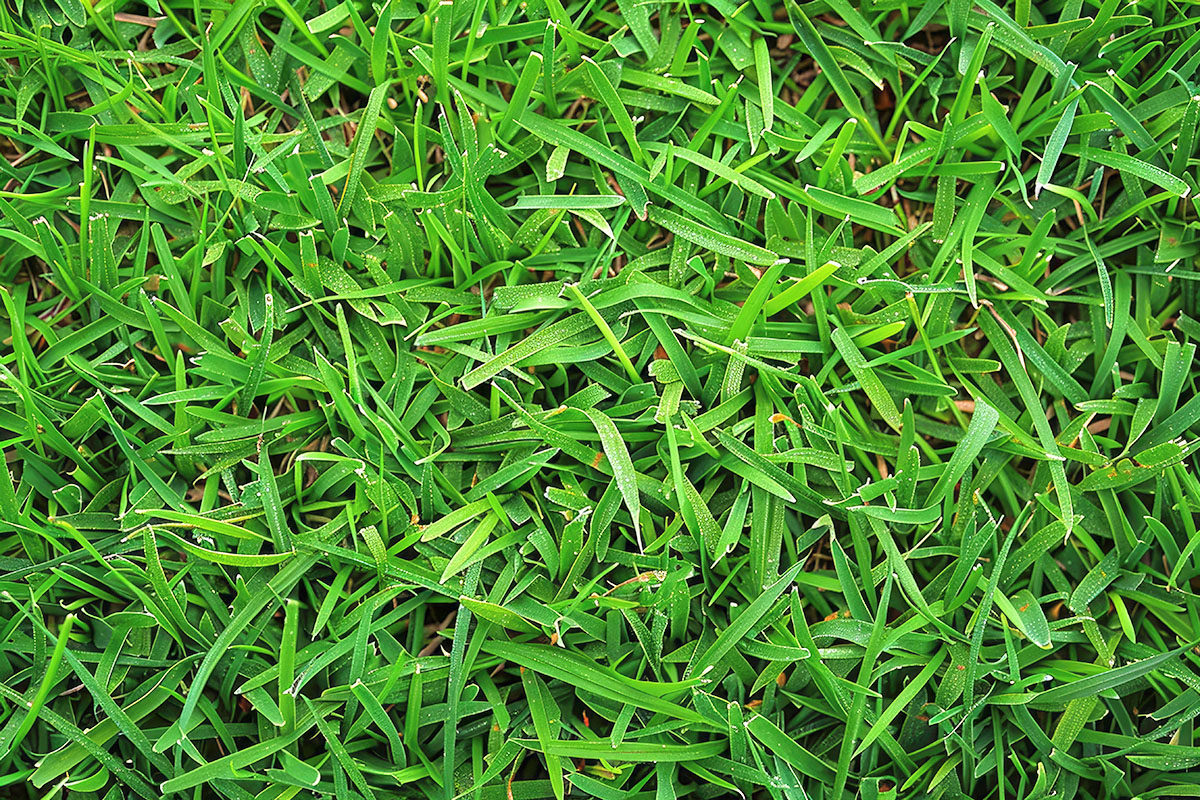
Zoysia has gained popularity in Central Florida in recent years due to its soft, dense, carpet-like appearance. It keeps weeds at bay, requires less mowing and fertilizer than St. Augustine and Bermudagrass, and feels nice to walk on.
On the downside, Zoysia is the first to enter winter dormancy and the last to green up in the spring. It’s also a slow-growing grass, more challenging to establish, and slow to self-repair after damage. To enjoy a strong, easy-to-care-for Zoysia lawn, consider hiring Orlando lawn care professionals to install and maintain it during its first few years of growth.
- Foot Traffic Tolerance: High, but slow to recover from wear
- Mowing Height: 1-2.5 inches
- Potential for Diseases: Low to moderate; dollar spot, rust, large patch
- Common Cultivars in Orlando: Empire
See Related: How Much Water Does Zoysiagrass Need?
4. Bermudagrass
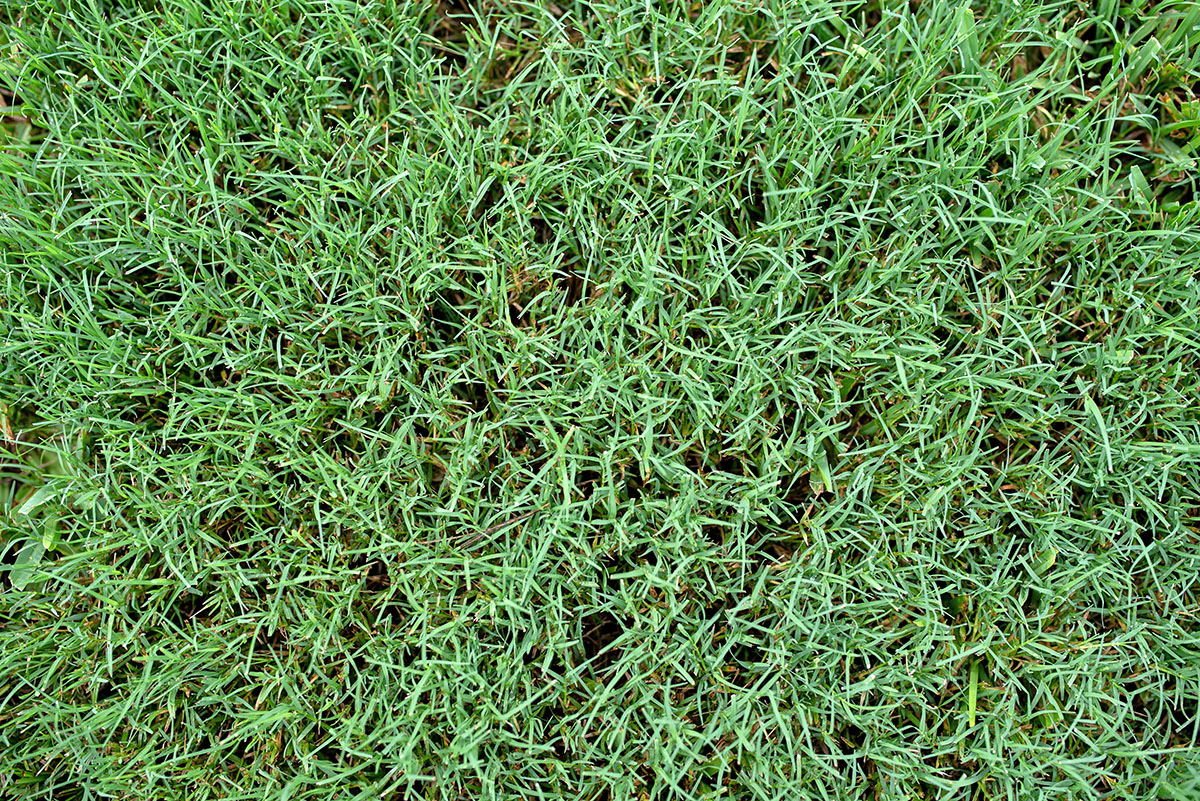
Bermudagrass is a high-maintenance turf that is well adapted to Central Florida’s climate and soils. It’s a beautiful grass, with fine-textured blades and dense growth. Very resilient to foot traffic, Bermuda is a common sight on Orlando’s golf courses, sports fields, and home lawns.
A full-sun, heat-loving grass, Bermuda thrives under Orlando’s intense UV exposure and should not be planted in shaded areas.
Note: Most homeowners opt for improved common varieties, since hybrid cultivars demand excessive upkeep for typical home lawns.
- Foot Traffic Tolerance: High
- Mowing Height: 1-2 inches
- Potential for Diseases: Low
- Common Cultivars in Orlando: Celebration, Tifway 419
See Related:
5. Centipedegrass
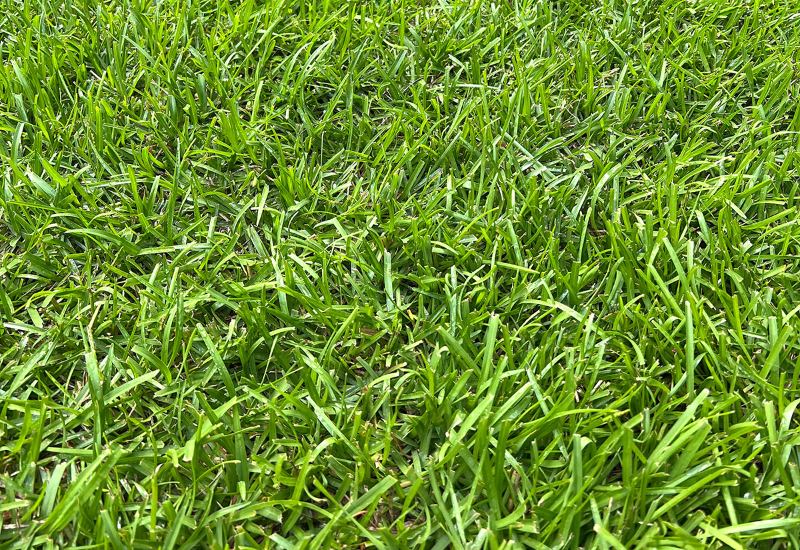
Centipedegrass does well in Central Florida, but it is actually the most common grass for homes in the Panhandle. This light green, slow-growing grass needs half the nitrogen and the mowing St. Augustine requires, making for a good low-maintenance option.
It does well in Orlando’s sandy, acidic, infertile soil and tolerates drought by going dormant. On the negative side, centipede turns chlorotic in alkaline and high-phosphorus yards and is prone to thatch, weeds, a nasty disease (centipede decline), and pests (nematodes, ground pearls).
- Foot Traffic Tolerance: Low
- Mowing Height: 1-2 inches
- Potential for Diseases: Moderate
See Related:
Best Grass for Overseeding: Ryegrass

Ryegrass is a cool-season grass that homeowners in Orlando use to overseed their Bermuda lawns in fall or winter to prolong the color. It sprouts and grows when the warm-season grasses go dormant, keeping the lawns green and beautiful throughout the winter.
You can plant perennial ryegrass or annual ryegrass; either way, it will wilt and die in the spring when the heat returns, making way for your warm-season turf to return. Water as needed throughout the winter and spring.
- Foot Traffic Tolerance: High
- Mowing Height: Mowing heights will depend on the warm-season grass you’re overseeding
- Potential for Disease: Moderate
See Related: How to Overseed a Lawn in 8 Simple Steps
Best Grass for Your Specific Location
While all the above grass types thrive throughout the Greater Orlando area, certain neighborhood characteristics can help guide your selection.
- Downtown Orlando/Lake Eola Area: Temperatures up to 9 degrees F higher caused by the urban heat island effect and higher aesthetic expectations favor St. Augustine, Bermudagrass, and Zoysia.
- Suburban Orlando (Winter Park, Oviedo, Apopka): Most grass types work well; choose Palmetto St. Augustine or Empire Zoysia for shaded lawns and bahia for large properties.
- South Orlando (Kissimmee, St. Cloud): Slightly warmer microclimate and larger properties favor drought-tolerant low-maintenance grasses such as bahiagrass and Zoysia.
No matter the type of grass you grow, proper maintenance is key for keeping your lawn healthy in Orlando’s climate.
“Smart watering, mow high, avoid heavy fertilizer, and add organic compost,” lawn care pro Robinson advises.
Best Grass Types for Orlando Compared
When choosing the best grass for your yard, consider the level of maintenance it requires and how well it suits your lawn’s conditions and uses (shade tolerance, soil pH, and traffic).
Orlando homeowners often choose grass by appearance, only to face costly problems later. To avoid mistakes, “consider Homeowners Association requirements to ensure they align with your budget, your values, and the level of maintenance you are prepared to support,” advise Hannah Eason and Calvin Gardner, Orange County UF/IFAS Extension specialists.
Another critical factor is assessing your yard’s light conditions. As the experts explain, “Shade level is going to have a big effect on turfgrass selection because most turf species do not do well under shade.”
The table below helps you compare the best turfgrass choices for Orlando using essential factors. For a faster decision, take the quiz above and learn what grass is best for your Orlando yard in less than a minute.
| St. Augustinegrass | |
| Pros: ✓ Easy to establish ✓ Beautiful dark green color ✓ Fast-growing ✓ Shade tolerant ✓ Tolerates alkaline soil | Cons: ✗ Requires lots of irrigation in summer ✗ Needs frequent mowing ✗ Develops thatch easily ✗ Moderate traffic tolerance ✗ Susceptible to diseases and pests |
| Bahiagrass | |
| Pros: ✓ Drought tolerant ✓ Low maintenance ✓ Cheap to grow from seed (can overseed itself if allowed) ✓ Pest and disease resistant | Cons: ✗ Less dense (ground visible through the grass) ✗ Slow growing ✗ Needs regular summer mowing to prevent seed stalks ✗ Doesn’t tolerate alkaline soils ✗ Low tolerance to shade, traffic, and salt spray ✗ Prone to weeds |
| Zoysia | |
| Pros: ✓ Needs less mowing and fertilizer ✓ Soft to walk on ✓ Dense and weed-resistant ✓ High traffic tolerance, but slow to recover from wear ✓ Cold tolerant ✓ Disease resistant | Cons: ✗ Slow to establish ✗ Recovers slowly from damage ✗ Develops thatch ✗ Longer winter dormancy |
| Bermudagrass | |
| Pros: ✓ Dense, carpet-like appearance ✓ High foot traffic tolerance ✓ Heat and drought-tolerant ✓ Thrives in full sun ✓ Good disease resistance | Cons: ✗ Needs frequent mowing ✗ Requires regular fertilization ✗ Low shade tolerance ✗ Tends to develop thatch |
| Centipede | |
| Pros: ✓ Grows well in sandy, infertile soil. ✓ Drought tolerant ✓ Low nitrogen requirements ✓ Needs less mowing | Cons: ✗ Light green color ✗ Slow growing ✗ Low resistance to traffic ✗ Prone to thatch and weeds ✗ Susceptible to diseases and pests |
| Ryegrass | |
| Pros: ✓ Soft-to-the-touch blades ✓ Medium to dark green color ✓ Germinates fast ✓ Not prone to thatch buildup | Cons: ✗ Not cold tolerant (doesn’t like temperatures below 30 degrees for long periods) ✗ Good traffic tolerance, but poor ability to recover from damage |
To keep your grass healthy and strong, pay attention to its specific needs, but also remember to adjust to Orlando’s changing weather.
“Keep an eye out for rain. If it’s raining constantly, you can safely turn off the sprinkler system,” says Orlando LawnStarter Pro Elvin Aponte of AAA Aponte Services LLC.
Make Lawn Care Easy: Hire an Orlando Lawn Care Pro

Choosing the right grass is just the beginning — maintaining it in the challenging climate of the Orlando area takes expertise. Skip the guesswork and let LawnStarter’s Orlando lawn care pros handle everything from installation to year-round care, so you can enjoy a gorgeous lawn without hassle.
We have local lawn care pros across the entire Orlando metro area. Whether you live in Winter Park, Kissimmee, Apopka, or Altamonte Springs, LawnStarter pros can keep your lawn healthy and thriving.
Read Next:
- Spring Lawn Care Tips for Orlando
- Winter Lawn Care in Orlando, FL
- 10 Basic Secrets to Lawn Care in Orlando, FL
- 8 Reasons to Care for Your Orlando Lawn
Main Image: Illustration by Whitney Lehnecker / LawnStarter; Adobe Stock photos
Sources:
- “Bahiagrass for Florida lawns.” By Laurie Trenholm, professor of horticulture (retired), Bryan Unruh, professor and turf extension specialist, and John Cisar, professor and turfgrass specialist (retired). University of Florida.
- Calvin Gardner, urban horticulture extension agent at the University of Florida, Orange County Extension, Orlando, FL. Personal interview.
- “Fertilizer Management.” Osceola County.
- “Fertilizer Ordinance.” Seminole County.
- Hannah Eason, commercial horticulture extension agent at the University of Florida, Orange County Extension, Orlando, FL. Personal interview.
- “Homeowners Guide to Bahiagrass Management in Florida.” By Alex Lindsey, assistant professor of Urban Turfgrass Management. University of Florida.
- “Homeowners Guide to Zoysiagrass Management in Florida.” By Alex Lindsey, assistant professor of Urban Turfgrass Management. University of Florida.
- “Lake County Reminds Residents of Summer Fertilizer Restrictions.” Lake County WaterAtlas.
- “St. Augustinegrass for Florida Lawns.” By turfgrass specialists Laurie Trenholm, Marco Schiavon, Joseph B. Unruh, Travis W. Shaddox, and Kevin Kenworthy.